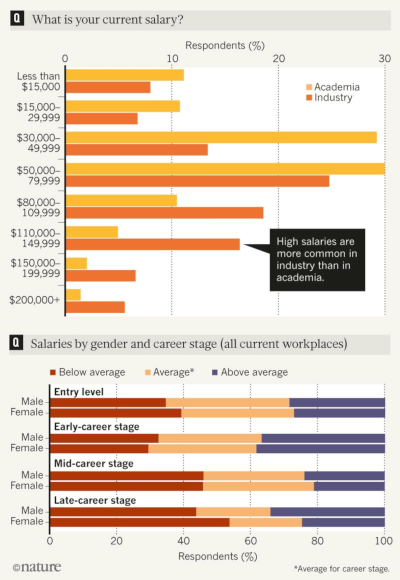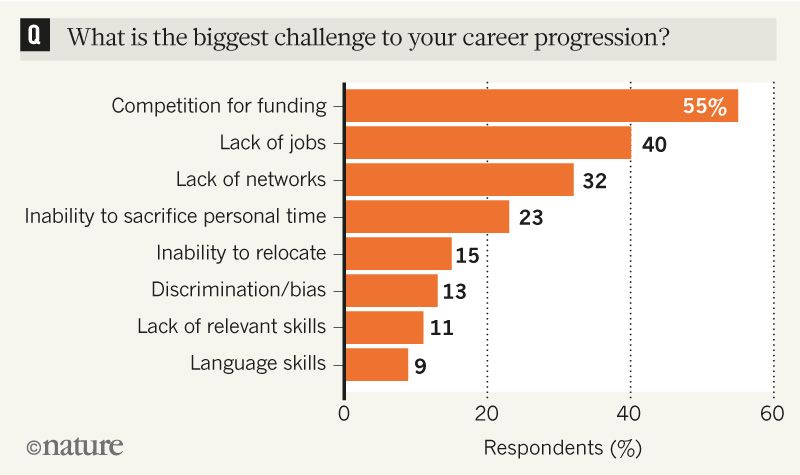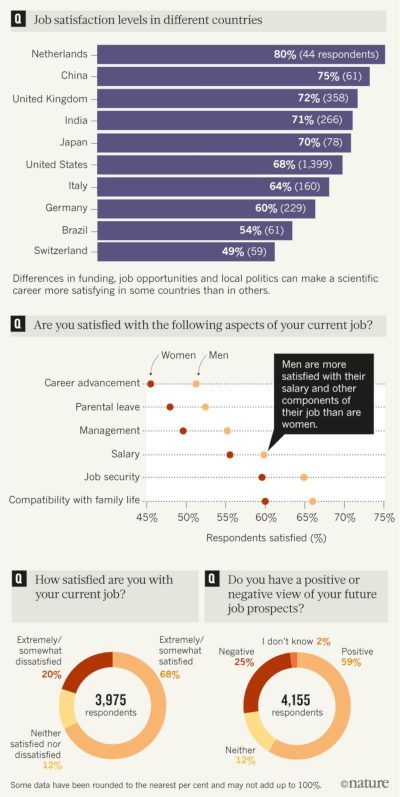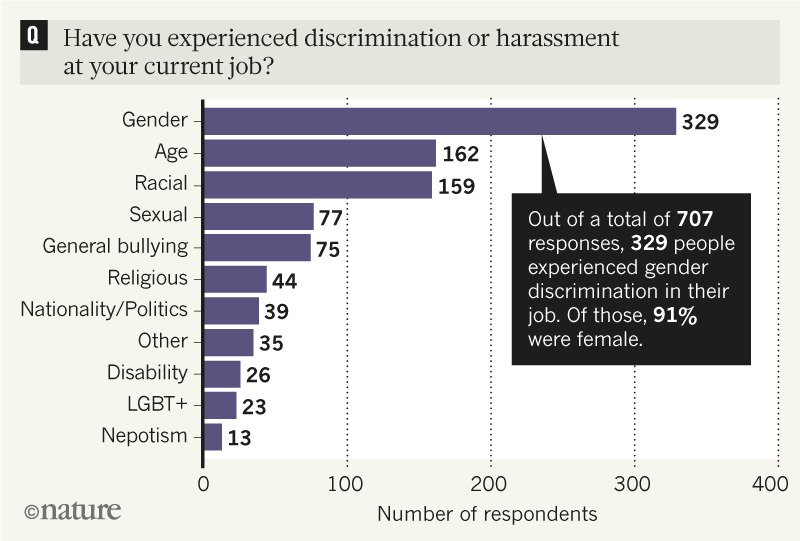
Views: 41
Nature’s survey offers a snapshot of salaries and career paths in the scientific sector.
Source Nature: Many science students and junior researchers continue to aspire to a career in academia, a dream that has persisted for generations. But Nature’s biennial survey of salary and job satisfaction in the global science community underscores an important reality: there is a vast number of career opportunities for scientists beyond academic research, and some of those options might be more rewarding, whether emotionally, financially or both.
Nature’s survey — for which fieldwork was conducted between June and July 2018 by Shift Learning, a London-based research consultancy — drew responses from 6,413 self-selected readers from around the world. (Responses from people who hadn’t gone beyond an undergraduate degree were filtered out, leaving a sample of 4,334.) Nearly 40% of respondents live in North America, 35% are in Europe and 16% are in Asia. Nature also heard from researchers in Australasia, Africa and South America.
The survey asked about salaries, job satisfaction, work–life balance, encounters with discrimination, mental health and other key issues that can define and shape a scientific career. The results, along with follow-up interviews with selected respondents, captured the diversity of the scientific experience, from the struggles to the triumphs. The data are available in full on Figshare.
More than two-thirds (68%) of respondents said that they were satisfied or very satisfied with their careers, a rate that is largely unchanged from the 2016 survey. Still, there’s no guarantee that those numbers will stay stable. Thirty-seven per cent of respondents said that their satisfaction had worsened in the past year, and just 32% said that it had improved.
A break-down of responses by employment sector showed how attitudes vary across the wide spectrum of scientific paths. Respondents working for non-profit organizations were especially likely to feel satisfied with their jobs (73%), followed closely by respondents in industry (71%), government (68%) and academia (67%). “This supports the fact that there are very fulfilling, high-paying jobs outside of academia,” says Susan Porter, dean and vice-provost of graduate and postdoctoral studies at the University of British Columbia in Vancouver, Canada.
Satisfaction numbers have shifted since the 2016 survey, which found a slightly higher proportion of satisfied scientists in academia (65%) than in industry (63%). The differences between the two surveys suggest that the balance between academia and industry has slightly tilted towards companies.
High levels of job satisfaction among researchers have been documented by other surveys, including one earlier this year of PhD holders by the University of British Columbia and one in 2016 of European researchers conducted by Vitae, a non-profit science-career advocacy organization in Cambridge, UK. But Vitae head Janet Metcalfe warns that job satisfaction isn’t always a sign of a positive working environment. “Researchers love doing research and therefore can have high job satisfaction, but they can still be experiencing high levels of stress and poor well-being,” she says.
Salary
Questions about salary revealed a deeper divide between sectors. Fifty-nine per cent of respondents in industry said that they were happy with their salaries; by comparison, only 40% of respondents in academia, 41% in non-profits and 49% in government said that they were happy with their pay. Overall, 43% of respondents said that they were happy with their salary. Just over half of all respondents reported a recent pay rise, but it clearly wasn’t enough to erase all disappointment.

Sam Proskin, a senior geotechnical engineer with Thurber Engineering in Calgary, Canada is pleased with his salary and career choices. He had hoped to land a job in academia as he finished his PhD in geotechnical engineering at the University of Alberta in Edmonton, Canada, in the mid-1990s. But after testing the academic waters in both the United States and Canada, and finding few opportunities and lots of stories of pressure and competition, he decided that a career in consulting would be a better fit for his skill set and ambitions.
Now, Proskin is in a position to offer advice to other young engineers and geologists who are pondering their futures. He encourages them to keep their options open and avoid the academia-or-nothing mindset. “Maybe it’s time to switch that thinking around,” he says. “The default mode should be that you are going into industry unless you’re very academically inclined.”
Mariana Pacheco Blanco, a postdoctoral researcher at BIOCEV, a biotechnology and biomedical academic research centre in Vestec, Czech Republic, is happy with her job in academia. But she also has a major complaint: she’s disappointed with the funding opportunities. “I spent five years in Germany where there’s a lot of funding for science,” says Blanco, who is originally from Mexico but earned her PhD at the University of Munster in Germany. “The difference between Germany and the Czech Republic is considerable.”
As a postdoc struggling to get by, she’s part of another great divide that might be even more fundamental than industry versus academia: the gap between the haves and the have-nots. Just 5% of respondents reported a salary of more than US$150,000 per year. Nearly 30% reported a salary between $50,000 and $80,000, and close to 25% said that they earned between $30,000 and $50,000. At the other end of the scale, 11% reported earning between $15,000 and $30,000, and 12% didn’t earn even that much.

Job titles matter when it comes to salary. Although a few professors, managers and research directors reported earning less than $15,000, that end of the salary range was dominated by teachers. About 50% of respondents who said that they are mainly teachers earned less than $30,000, and nearly 30% of research or staff scientists were at the same modest place on the salary scale. The upper ends of the scale were populated mostly by full professors, managers and research directors.
As with the 2016 salary survey, geography proved to be a strong determinant of salaries. Nearly 40% of respondents in Asia reported earning less than $15,000 a year, compared with 2% of respondents in North America. At the top level, 11% of all respondents in North America and Australasia reported earning more than $150,000, putting them far ahead of other regions. Pockets of hardship continue to persist in Europe. Just over 20% of respondents in Europe reported earning less than $30,000 a year compared with just 5% of those in North America — a gap that is unchanged from our 2016 survey.
The survey also reflected gender disparities in salary, especially in scientists who had been in their profession for many years. Among respondents who said that they were in the later part of their career, 33% of men reported earning more than $110,000 a year, but only 23% of women reached that level. For entry level, early-career and mid-career respondents, income brackets were fairly evenly split between the genders. Women were also more likely than men to report being unhappy with their salaries (59% compared with 53%).
The question “Are you happy with your salary?” turned out to be an exercise in relativism. More than 20% of respondents who earned more than $150,000 a year said that they were unhappy with their salaries, whereas 27% of people who earned between $15,000 and $30,000 a year reported that they were happy with their lot, probably because that range fit their expectations and cost of living.
Shrisha Rao, a computer scientist at the International Institute of Information Technology in Bangalore, India, hasn’t reached a lofty income bracket, but is happy with his salary and gratified with his work. “I’m fortunate to be at an institution that values me,” he says. “I’m not making more than people in the United States, but my income is high for my country and my profession.”
Job path
Still, unsurprisingly, academia remains a popular destination: nearly three-quarters (70%) of respondents said that it had been their main goal as they finished their PhDs, which is in line with the aspirations of students who responded to Nature’s 2017 graduate-student survey (see Nature 550, 549–552; 2017). Blanco, who studies non-Hodgkin lymphoma, says that she is highly satisfied with her job, mainly because she is finds her topic compelling. “I’m working on cancer, which makes the science more exciting,” she says. “It’s the hot spot everywhere.” But she gives even more credit to her supervisor, cancer biologist Ondrej Havranek, who, is generous with his time and advice, and doesn’t demand long hours from his team. “If I want to leave at 5 p.m., I can leave at 5 p.m.,” she says. “He respects my private life, which can be a problem for some people in academia.”

Rao, who earned his PhD at the University of Iowa in 2005, says that he has had his sights set on academia since the early days of his science training. As a professor at a technology institute where he studies cloud computing and resource utilization, he feels that the plan paid off. “I enjoy a lot of academic freedom,” he says. “People aren’t telling me what to do on a regular basis.” Still, he says, “My peers and I would be happier if we had more resources. India punches below its weight when it comes to science. That’s a hard fact.”
Satisfaction
Finding enough hours in the day to maintain both a career and a personal life can be a challenge no matter where a scientist works. Although most respondents were satisfied with their own work–life balance, this is another area where industry seemed to have an edge over academic life: 79% of respondents in industry said that they were somewhat or extremely satisfied with this aspect of their career, compared with 68% of respondents in academia.
Job satisfaction is a multifaceted matter. When asked to identify the factor that was most important to satisfaction, respondents put ‘interest in the work’ at the top of the list. That factor also ranked highest in terms of actual satisfaction — a happy case in which something that’s deemed important actually delivers. Still, other aspects of being a scientist are dragging respondents down. Survey participants were generally unsatisfied with their ability to influence decisions that affect them, job security, career-advancement opportunities and recognition for achievements — all things that they felt were important in making a job worthwhile.
Well-being
Respondents were also frank about the negative effects of their work on their mental health. Sixteen per cent of those surveyed said that they had either received help or were currently getting help for depression or anxiety. Seventeen per cent said that they had not received help but would like to. And 3% had sought help but had yet to receive it. Those responses follow a pattern of widespread unease in science. In Nature’s 2017 graduate-student survey, 12% of respondents said that they had sought help for anxiety or depression that was directly caused by their studies.
Instances of harassment and discrimination — problems that remain stubbornly common in science — can, of course, also undermine researchers’ job satisfaction or ability to perform their job. More than one-quarter (28%) of respondents reported observing such problems at their current job, and more than one-fifth (21%), said that they had personally experienced such treatment. Of those who said that they had witnessed or experienced some sort of discrimination, nearly half (47%), said that they had experienced gender discrimination, the most common type. Ninety-one per cent of respondents who said that they had personally experienced gender discrimination were female. Discrimination based on age (23%) or race (22%) were also relatively common.

About half of all respondents felt that their workplace is doing enough to promote diversity. Those working in industry (58%) were more likely than those in academia (50%) to say that their institution is on top of the issue. Hannah Murfet, a quality compliance manager at Microsoft Research in Cambridge, UK, gives her employer high marks. “Where I work now, the mission is very centred on diversity and inclusion,” she says.
Murfet, who is an advocate for women in science, helped to form the Next Generation Network, a group dedicated to helping young researchers learn about careers in compliance and quality control, an increasingly in-demand career option that many scientists fall into almost by accident. “It would be great if more people could consider this opportunity,” she says. Most of all, she wants to encourage young people to keep their minds open to a wide range of options. “If you’re interested in industry, find an opportunity to get in — it can take you where you want it to,” she says. “You don’t have to stay as a bench scientist. You can move into marketing, sales or compliance.”
Nearly 60% of respondents feel positive about their future job prospects — a rate that hasn’t changed much from the 2016 survey — but that optimism is not evenly distributed. Scientists were more likely to have a rosy outlook if they had a full-time job and were under the age of 40 and male. The 25% with a negative outlook were more likely to be female and to have a temporary contract. On another pessimistic note, more than half (51%) of respondents said that their job prospects are worse or much worse than they were for previous generations. Still, a full 75% of respondents said that they would recommend a career in scientific research to students — a marked increase from the 61% who took that position in the 2016 survey.
One of those science supporters is Aaron Pan, executive director of the Don Harrington Discover Center, a science museum in Amarillo, Texas. Pan started a postdoc at Southern Methodist University in Dallas, Texas, after earning a PhD in palaeobotany, and was planning to continue on the academic path until another option opened up. He applied for a curator position at the Fort Worth Museum of Science and History in Texas, and his career trajectory changed forever. “I think I would have been happy on many different paths,” he says. “Here, I still get to do research, but it’s research I want to do. I don’t have to publish just to get tenure.”
Whether in academia, industry, non-profits or government, there are lots of places to do science, and lots of ways to be a scientist. The Nature survey highlights the diversity of options, but it also points to issues that all researchers should keep in mind as they plot their course. From salary to job satisfaction, many things can go right — but they might not. The good news is that science, for most, will always be interesting. And that can be just enough to keep a person going.
Nature 562, 611-614 (2018)
Leave a Reply